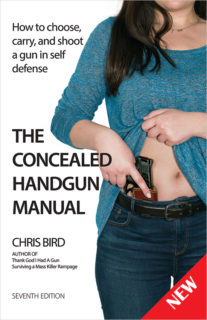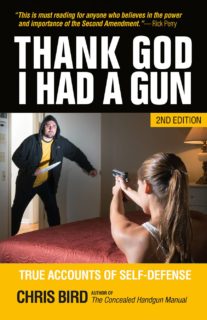Safety Rules
In the past couple of months, I have had shooting students point guns at me while on the range. In both cases the students were retired military and should have known better. However just because someone has served in one of our military branches doesn’t mean they know anything about handguns. It also is why Texas Department of Public Safety range officers wear bullet resistant vests.
The first occasion happened when somehow the web between the student’s thumb and forefinger became stuck between the slide and frame of his pistol. He was yelling because it hurt and I was yelling at him to point the gun down range.
The second incident was when we were doing a drill with two chairs representing the seats in a car. The passenger had a holstered gun while the driver was unarmed. The threat (target) was on the driver’s side. The passenger had the option of handing his gun to the driver or getting out of the vehicle and shooting the target from behind the engine block. When the passenger drew the gun he managed to point it at me before dealing with the threat.
With these incidents in mind, this seems to be an appropriate time to go over the four main safety rules as they apply to firearms. While there are other rules for gun safety, these are the four most important ones.
1. TREAT ALL GUNS AS THOUGH THEY ARE LOADED.
Guns that people thought were unloaded are the biggest cause of firearms accidents, particularly when kids get hold of a handgun and start playing with it. If you handle all guns as though they are loaded, you will avoid such tragedies. All defensive weapons should be kept loaded and handy all the time. An empty gun or a loaded gun kept locked in a gun safe is not going to be much good if you need it in a hurry. However, you must ensure that children and other adults do not have access to your guns. Their handling habits may not be as safe as yours. One of the most frequent causes of accidents with semi-automatic pistols is when someone removes the magazine but forgets or doesn’t know there is still a round in the chamber.
2. ALWAYS KEEP THE MUZZLE POINTED IN A SAFE DIRECTION, UNLESS YOU ARE DEFENDING YOURSELF OR OTHERS.
A “safe direction” is defined as where, if the gun goes off, there will be no injury to man, woman, or beast, and there will be minimal property damage. That means keeping the gun pointed at the backstop when on the range and never at people or pets. I have used the safe direction rule to replace the rule often touted in safety rules: do not point your gun at anything you are not willing to destroy. During routine handling of your gun you will point it at things you do not want to destroy – walls, the floor, furniture etc. Pointing the gun at the ground is usually fairly safe, but remember that walls, particularly apartment walls, are not necessarily bullet-proof and bullets ricochet off hard surfaces. Always practice drawing your weapon and dry firing it in a safe direction. If you shoot enough, you will almost certainly fire a shot by accident at some time, but if you always keep the muzzle pointed in a safe direction, the result will do no more than scare the daylights out of you and require you to change your underwear. In a shooting career that has spanned more than fifty years and many thousands of rounds, I have fired three shots accidentally. Two of the bullets went harmlessly down range. The third one left a .45-caliber hole in a window before burying itself in a stream bank outside. I had been practicing drawing and dry firing my revolver and thought the gun was unloaded. In each case, the gun was pointed in a relatively safe direction, and in each case I was shocked and embarrassed. Develop safe habits. Don’t let the muzzle cover anybody when you are turning or passing a gun to someone. I have seen people who should know better wave their guns around, casually covering anyone in range when they “know” the gun is “empty.” As mentioned above, it’s only “empty” guns that kill people by accident. I make no apology for repeating it. Imagine that your gun has a wooden dowel or a laser beam extending from the barrel. This way you will always be conscious of where the muzzle is pointing.
3. KEEP YOUR FINGER OUTSIDE THE TRIGGER GUARD UNTIL YOU ARE ON TARGET AND HAVE MADE THE DECISION TO SHOOT.
When I was taught to shoot in International Practical Shooting Confederation (IPSC) competition in Canada, we were taught to load, reload, unload, and move from one firing position to another with the trigger finger lying alongside the trigger guard—not on the trigger; not inside the trigger guard. I remember being ordered off the range during the first string of a match for reloading with my finger on the trigger. I learned, and now whenever I pick up a gun, my finger automatically slips into position alongside the frame. It touches the trigger only when I am pointing the gun at the target and have decided to shoot. A couple of decades ago, most holsters carried the gun with the trigger exposed. Today almost all of them enclose the trigger so that a finger cannot reach the trigger until the gun is drawn. Get into the habit of putting your finger on the trigger only when the gun is coming onto the target and you intend to fire. This replaces the rule: “Keep your finger off the trigger until you are ready to shoot.” Emmanuel Kapelsohn, a firearms instructor, lawyer and expert witness has defended police officers in shooting incidents. He told me of defending an officer who had been taught to keep his finger off the trigger until he was ready to shoot. The officer was chasing a suspect, had his gun out and his finger on the trigger because he wanted to be ready to shoot. He grabbed the suspect by the collar as the suspect swept his arm back. His arm hit the officer’s gun causing it to discharge killing the suspect. His agency changed their training. Kapelsohn also said the rule: “On target, on trigger; off target, off trigger,” is also a bad rule. If you are covering a criminal with your gun, you are on target but you still don’t want your finger on the trigger.
4. BE SURE OF WHAT YOUR BULLET WILL HIT BEFORE YOU SHOOT.
Trick shooter Ed McGivern fired thousands of rounds at aerial targets in rural Montana in the 1930s. I shot tin cans thrown into the air in the wilds of British Columbia in the late-1960s. However, there are fewer and fewer places where this can be done safely. It is certainly unsafe to shoot into the air in a city. When I was a newspaper reporter in San Antonio, I covered a case where someone was celebrating July 4 by shooting a gun in the air. The bullet came down hitting a teenager in the head. He didn’t die but he did suffer brain damage. Bullets fired horizontally can also take unexpected paths if they hit a hard surface and ricochet. Imagine being attacked by a mugger in front of the polished granite wall of a bank. You fire three shots at your assailant. Two hit, but the third strikes the granite wall and ricochets, striking a woman standing half a block away at a bus stop. Now, you almost certainly face a civil suit. If your life was in danger, your decision to shoot was right. It’s better to be alive and facing a civil suit than dead and facing the undertaker. But it is something to think about. Remember, most apartment walls and many house exterior walls are not bullet-proof. I have seen many houses with stucco walls that have been shot up by gang members armed with rifles, shotguns, and handguns. Many of the bullets went in through the front wall, pierced several interior sheetrock walls, and went out through the back wall. Invariably the reason I was there was because someone, often a sleeping child, had been wounded or killed, and I was reporting the story.
There are other safety rules but if you remember and follow these four, you will avoid any tragic accidents. Stay safe.



